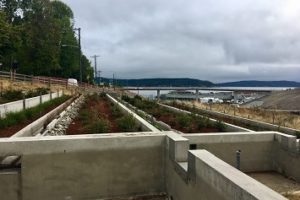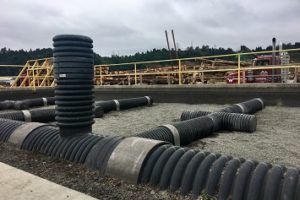On the final day of the StormCon 2017 Surface Water Quality Conference and Expo, a busload of stormwater professionals toured two innovative stormwater management systems recently installed in the City of Tacoma’s Point Defiance Park and the Port of Tacoma’s West Hylebos Pier Log Yard. Both facilities use cutting edge technologies within relatively small footprints to treat stormwater from challenging watersheds, and in doing so, provided food for thought for attendees seeking to implement similar systems in their own cities and industrial facilities.

Point Defiance Regional Treatment Facility
Completed in December 2015, the Point Defiance Regional Treatment Facility is situated on a steep slope at the northeast entrance to Tacoma’s Point Defiance Park and is designed to treat up to 8 million gallons of stormwater from a watershed of 754 acres. The watershed itself is located entirely within the Tacoma Asarco Smelter Plume and partially within a Superfund site, and it discharges to a waterbody impaired for arsenic, copper, lead, and zinc. As a result, the City of Tacoma was tasked with designing and implementing a large scale stormwater treatment system that could remove a high level of pollution from its runoff before discharging it to an already compromised area of Puget Sound.
The resulting 5,500 square foot treatment facility is comprised of a series of cascade pools, distribution troughs, and treatment cells. Stormwater enters the facility through the six cascade pools and is diverted into distribution channels. Any remaining stormwater overflows through a weir and is conveyed to the next pool. The stormwater proceeds through the distribution troughs and drops into parallel treatment cells, which contain vegetation, mulch, and filtration media. The treated water then travels from a drain system beneath the filtration media into a bioswale, which ultimately conveys the stormwater to the Point Defiance Marina and Commencement Bay. Due to its open plan, the facility is easy to access for both maintenance and monitoring purposes.
To date, the facility has received a number of industry awards and has served as a model in the development of larger stormwater treatment facilities around the country, especially for those located in impaired watersheds. By combining several best management practices (BMPs) into one treatment facility and by partnering with several area stakeholders, the City of Tacoma was able to maximize the use of the space and funding available. The project ultimately cost about $2.4 million, and a number of StormCon attendees remarked on the relatively inexpensive price tag and expressed interest in implementing something similar at their own facilities.
West Hylebos Pier Log Yard
The StormCon tour then moved to the Port of Tacoma’s West Hylebos Pier Log Yard where a state-of-the-art pretreatment media filtration and biofiltration stormwater treatment system was installed in December 2013. The facility, a 25 acre waterfront log sort yard, is covered by the State of Washington Department of Ecology (WDOE) Industrial Stormwater General Permit and had historically experienced difficulty meeting the benchmarks for total suspended solids (TSS), turbidity, chemical oxygen demand (COD), zinc, and copper. As a result, the Port of Tacoma worked with Kennedy/Jenks Consultants to develop a treatment system that would address its unique economic, geographic, and contaminant constraints.

The innovative design, which is 600 feet long and 40 feet wide, uses a series of treatment cells. The first cell feeds stormwater through a distribution system and filters it through uniform pea gravel to remove heavier solids. The water then gravity feeds through an underdrain and a distribution pipe into the second cell, which contains filtration media made of coarse sand, gravel, and bio-char derived from wood waste made into charcoal. The water is then pumped and fed to the third and fourth bioretention cells.
Since being brought online, the treatment system has allowed the facility to meet the benchmarks for all six required parameters and, like the Point Defiance facility, has won many industry awards. Before this project, biofiltration had never been used to treat runoff from log yards. By applying existing technologies in a new context, the West Hylebos Pier Log Yard showcases how innovation from the stormwater industry can help facilities manage complex and challenging watersheds.
Innovation as Inspiration
By using outside-the-box solutions to effectively manage stormwater from large and problematic watersheds, both the Point Defiance Regional Treatment Facility and the West Hylebos Pier Log Yard biofiltration system offered StormCon attendees the opportunity to study advances in green stormwater infrastructure first hand. In combining many traditional BMPs into one facility, applying existing technologies in new settings, and collaborating with area stakeholders, both projects were able to efficiently manage and treat their stormwater within their unique geographic and contaminant constraints. Judging from the audience’s reaction, many stormwater professionals are eager to take the lessons learned from these projects back home to address challenges around the country.
